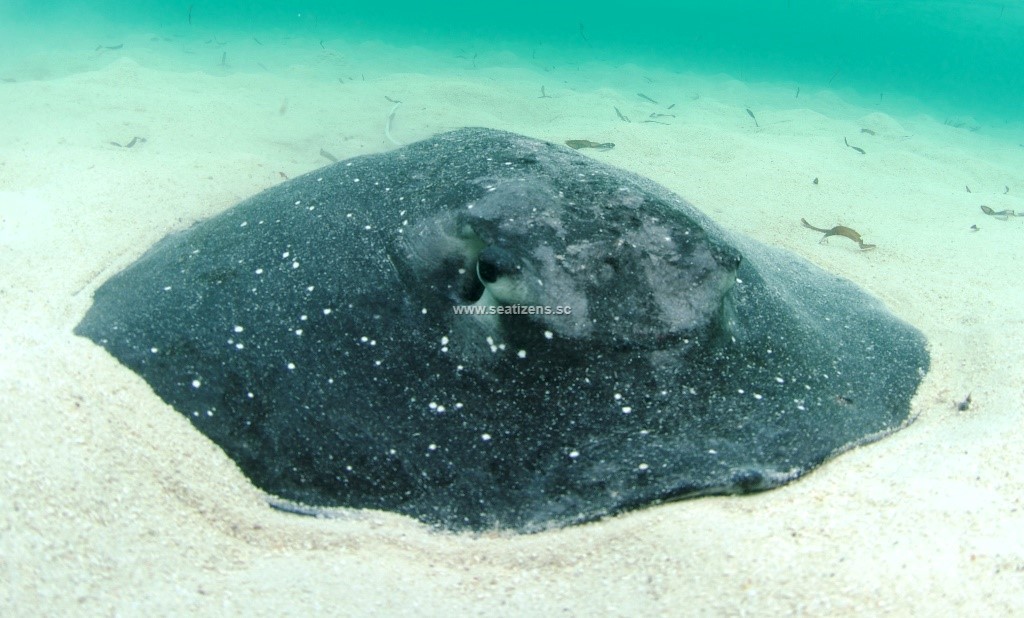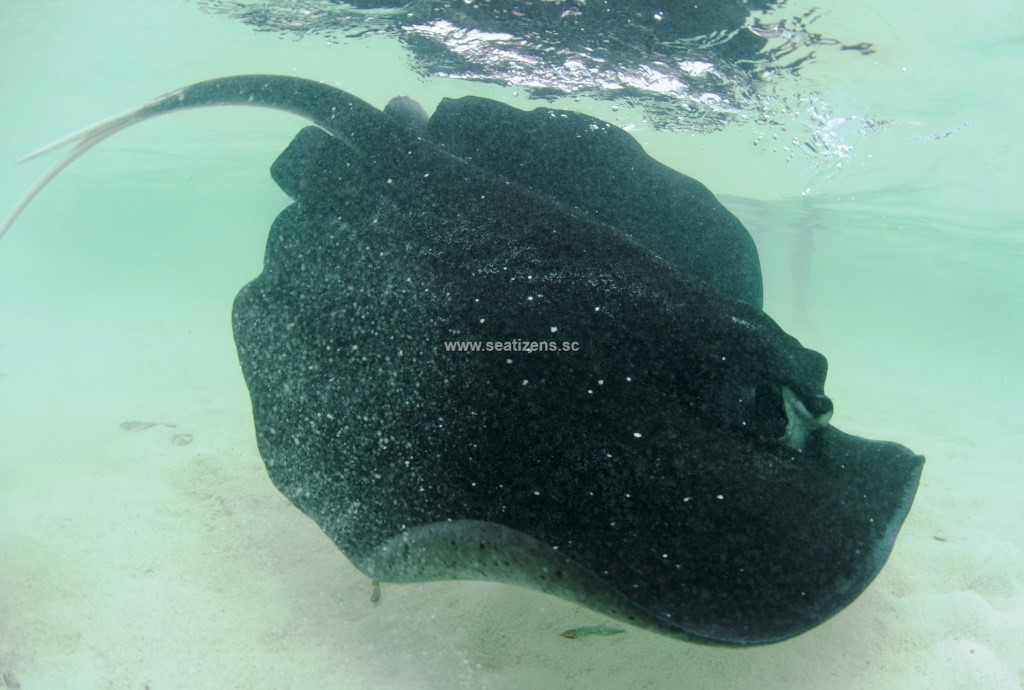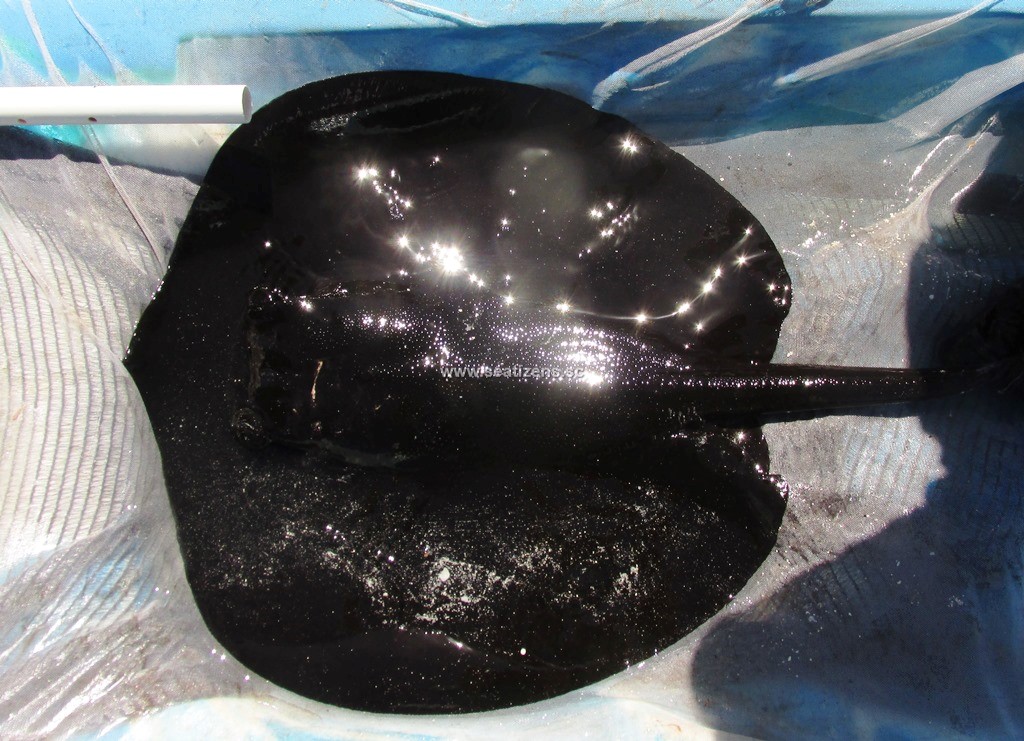Description:
A large whip ray, thick bodied, with an oval disc, rough skin and well-developed band of denticles on central disc. Markedly longer than wide, the pectoral fin apex is broadly rounded. Snout short, with a weak apical lobe, eyes small and protruding. Mouth small with prominent labial folds and 2-7 oral papillae. Nasal curtain small, with posterior margin finely fringed. Tail broad-based, subcircular in cross-section tapering gently to caudal sting beyond which it becomes whip-like. 1-2 caudal stings.
Colour. Dorsal surface greyish or yellowish brown, with small white flecks and often covered with dark mucus. Ventral surface white in young, with dense black blotches in adults. Broad dusky or black margin usually around most of disc and outer edges of pelvic fins.Tale white behind Sting.
Size:
Maturity: Males mature at 55-65cm DW. Max size: 141cm DW (exceeding 350cm TL). Birth size approximately 14cm DW.
Habitat and Ecology:
Young live mainly in mangroves and estuaries, also over sand and rubble in lagoons. Adults in lagoons and on coral reefs on the conrtinental shelf (depth 1-85m). Feeds mainly on crabs and prawns. Distinct pairing with embrace. Ovoviviparous, with histotrophy. Fully developed young, size at birth approx 14cm DW. An uncommon stringray throughout its range it also appears to be solitary rather than forming aggregations. At St Joseph Atoll, however, adults are reported as solitary but juveniles are known to aggregate (Elston, C. pers comm).
Fishery Status:
This species is not protected or subject to fishery regulations. It was not recorded in the catch durng a 7-year survey of the artisanal fishery (Nevill, J. Artisanal Fishery elasmobranch catch survey 2013-2019).
Notes:
First documented in Seychelles at St Joseph Atoll in the Amirantes in 1992, by Randall and van Egmond (1994). The specimens shown here, courtesy of Chantel Elston and Rainer von Brandis, were also photo'd at St Joseph's Atoll.
Its status on the Mahe plateau is uncertain. The degradation of mangroves and targeting of juveniles in shallow waters are thought to have significantly impacted this species around continental landmasses. It is not unreasonable therefore to project that such activities in the relatively small areas of habitat in the central archipelago may have resulted in the species extirpation there.
References:
Froese, R. & Pauly, D. Eds. 2021. FishBase. World Wide Web electronic publication. www.fishbase.org. https://www.fishbase.se/summary/12586 (17/04/21).
Last, P.R. et al (2016). Rays of the World. CSIRO Publishing ISBN 9781501705328
Manjaji Matsumoto, B.M. et al (2020). Urogymnus granulatus (amended version of 2016 assessment). The IUCN Red List 2020: e.T161431A177282313. https://dx.doi.org/10.2305/IUCN.UK.2020-3.RLTS.T161431A177282313.en. (17/04/21).
Randall, J.E, & van Egmond, J. (1994). Marine fishes from the Seychelles: 108 new records. Zoologische Verhandelingen, 297(3), 43–83.
Urogymnus granulatus (MACLEAY, 1883): In: Database of modern sharks, rays and chimaeras, www.shark-references.com, World Wide Web electronic publication, Version 04/2021. https://shark-references.com/species/view/Urogymnus-granulatus (17/04/21).
Citation:
Nevill, J.E.G. & Elston, C. (2021). Urogymnus granulatus, Mangrove whipray. Seychelles Seatizens. www.seatizens.sc https://seatizens.sc/species/urogymnus-granulatus-macleay-1883/




I am so grateful for your post. Great.
I truly appreciate this blog article.Thanks Again. Awesome.
Thanks for the blog article.Much thanks again.
I think this is a real great blog post.Thanks Again. Keep writing.
Thanks-a-mundo for the blog article.Really looking forward to read more. Awesome.
Appreciate you sharing, great article post.Much thanks again. Want more.
I really like and appreciate your post.Really looking forward to read more. Really Great.
Fantastic post.Really looking forward to read more. Great.
A big thank you for your post.Really thank you! Really Great.
Really informative blog.Really thank you! Keep writing.
Very informative post.Really looking forward to read more. Much obliged.
Enjoyed every bit of your article post.Really looking forward to read more. Really Great.
Appreciate you sharing, great blog article.Really looking forward to read more. Awesome.
Enjoyed every bit of your article post.Really looking forward to read more. Awesome.
Thank you for your blog.Really thank you! Cool.
Awesome article post.Really thank you! Cool.
Really appreciate you sharing this article post.Thanks Again. Much obliged.
Im obliged for the blog.Thanks Again. Cool.